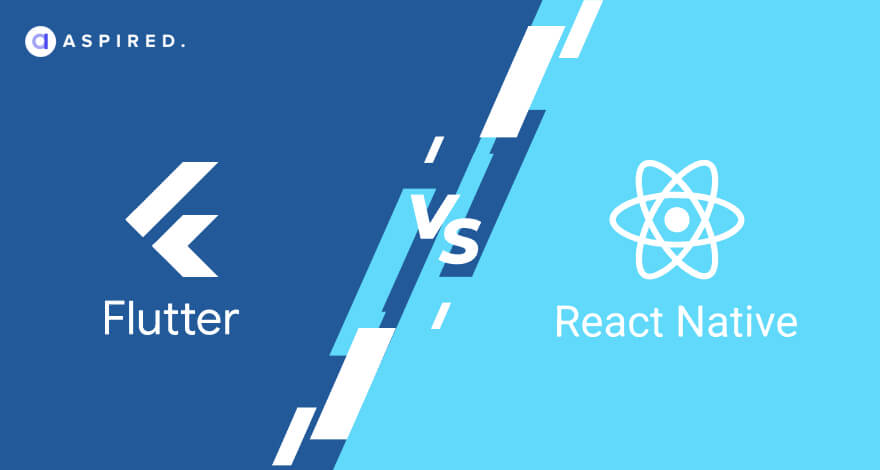When it comes to Cross-Platform Frameworks, Flutter, and React Native have been the talks of the tech town for quite some time now. Both were created by the world’s current tech titans, Google and Facebook. Developers are eager to develop cross-platform mobile applications whispering their names in hushed tones. These two formidable frameworks have entered the digital lexicon. Their features and benefits are discussed with reverence reserved for recent technological advances. However, the question of what to utilize to develop the best experience an application can offer has existed for some time.
What Motivates Us to Write This Post
At Aspired, we empower businesses by providing practical solutions and delivering tangible value, whether it’s cutting-edge AI projects or finding the perfect development team for creating cross-platform apps. We understand the unique needs of businesses and take a collaborative approach by matching their project requirements with the finest development team that drives success. However, our clients are always curious to know about the ongoing tech trends and, in this case, top cross-platform app development, such as Flutter and React Native. So here we compile their shared queries.
- What is the difference between Flutter and React Native?
- What criteria should I consider when comparing Flutter vs. React Native?
- What are the pros and cons of Flutter and React Native frameworks?
- How should I evaluate industry trends in Flutter vs. React Native to ensure optimal future community support for my app?
- Should I pursue native app development on native platforms or cross-platform application development?
In this post, we aim to provide a holistic understanding of Flutter and React Native so you may make a more informed decision for your next potential cross-platform development project.
Before going into detail, let’s understand what cross-platform frameworks are and how they work.
What Are Cross-Platform Frameworks?
Cross-platform development frameworks are software tools that enable developers to write software programs compatible with multiple operating systems.
How They Work
- These frameworks let developers write code once and deploy it on iOS, Android, and Windows. Eliminating platform-specific code saves time and resources.
- Cross-platform development frameworks offer a consistent user experience across devices and platforms. Developers work with a single codebase, making application maintenance and update more accessible.
- React Native, Xamarin, Flutter, and Ionic are cross-platform frameworks. Developers must pick the proper framework based on its capabilities and benefits.
Let us compare the top cross-platform frameworks to help you choose the best match you need for your project.
What is Flutter?
Flutter is a mobile UI framework. It is a complete Software Development Kit (SDK) for app development that includes widgets and tools. Source
Why is Flutter used?
Flutter enables cross-platform app development. It makes it simpler for developers to create and deploy aesthetically appealing, natively-compiled mobile (iOS, Android), web, and desktop applications, all from a single codebase.
A Little more on Flutter
- It's free, and the source code is available to all.
- Dart, a rapid, object-oriented programming language, serves as its foundation. It's relatively new and simple to learn, especially for those more comfortable with Java and C#. Dart further supports proper null safety.
- It provides its widgets, rendered by its high-performance rendering engine; these are quick, aesthetically pleasing, and customizable.
- Flutter apps look and feel excellent due to the widget experience (while you can still create your custom app design using readily-available UI elements that follow specific platform guidelines).
Famous apps built with Flutter
Many world's largest corporations have used Flutter to develop innovative mobile apps. According to the official Flutter Medium channel, more than 500,000 apps have been built and deployed with the help of Flutter. Here are some of the popular apps
- Ali baba
- Google ads
- Hookle
- Google Pay
- Byte dance
- Crowdsource
- eBay
- Hamilton
- Nubank
- Supernova
- Tencent and others
What is React Native
React Native is an open-source JavaScript-based mobile application framework. Statista
Why is React Native used?
React Native is an efficient architecture for:
- Cross-platform programming
- Developing mobile applications using JavaScript
- Building Android and iOS applications from the same codebase.
A little more on React Native
React Native applications are not mobile web applications. Instead, React Native employs the same fundamental UI-building components as conventional iOS and Android apps. This means that instead of building in Java, Kotlin, or Swift, you use JavaScript and React to assemble the same building blocks.
Famous apps built with React native
React Native is a popular framework for app developers, regardless of the app's size and scope. The Facebook App is likely one of the most popular apps based on React Native design. Here are some others:
- Walmart
- Tesla
- Wix.com
- Skype and others
Flutter vs. React
|
Parameters |
React Native |
Flutter |
|
Language |
Java Script |
Dart |
|
Documentation |
React Native has general documentation. However, the framework relies extensively on third-party dev kits. |
Due to its structure and detail, it provides easy-to-read, more detailed documentation. |
|
Performance |
React bridges native components with JavaScript. Hence, development and runtime are slower than Flutter. |
No bridge connects native device components. Native components interact faster. |
|
User Interface |
React Native uses more native Android and iOS components. In addition, it has many external UI kits for designing attractive app interfaces. |
Flutter employs aesthetic, structural, platform, and interactive widgets that are unique. These widgets are UI components that are built-in and replace platform-native parts. |
|
Industry Trends |
62.5% of developers loved React Native in the 2019 StackOverflow survey. Moreover, it offers improved job prospects due to its longevity and use of React and JavaScript. |
Flutter ranked higher with 65.4% of the vote. However, flutter is relatively new and is utilized by fewer businesses. This results in fewer employment opportunities. |
|
Popularity |
React Native is more popular than Flutter. Many developers prefer React because they can quickly create react native mobile apps. |
Despite the recent interest, Flutter has fewer developers. In addition, developers embrace Dart slower because it's new. |
|
Community Support |
With over 310,507 categorized questions on Stack Overflow, React Native is the most popular framework. |
Flutter's community is small and new. But, slowly, more developers are adopting it. Stack Overflow has 89,638 questions. |
Pros and Cons of Flutter
|
Pros of Flutter |
Cons of Flutter |
|
|
|
Pros and cons of React Native
|
Pros of React Native |
Cons of React Native |
|
|
|
Closing
Both Flutter and React Native are great options for developing cross-platform applications. However, before picking which one to employ, you should know their significant variances and commonalities.
Selecting the appropriate cross-platform framework for your application or startup app concept primarily depends on the native aspects that your project needs, the development team, and the team’s development experience.
Each framework has the potential for your application to spread its wings and fly. We hope this post helps you choose the right framework. We'll keep our fingers crossed for you and wish you the best of success in your next steps!
If you need help with your mobile app development, whether you need Flutter or React Native developers, Aspired can help. Our team of experts will consult with you on all matters, leaving you confident about your development needs. So, don’t hesitate to contact us today and take the first step toward building your dream app!

 Clients
Clients
 Processes
Processes
 Blog
Blog










